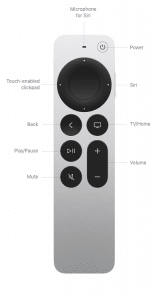
Why the (existing) AppleTV remote is terrible
Like or dislike Apple computers, smartphones, or tablets, just about everyone agrees that Apple has really pushed the limits of aesthetic design and ergonomics for tech products. Except for the AppleTV remote.
So why the strange situation that most of us hate the physical remote control that comes with the AppleTV?
There isn’t just one thing, it’s everything:
The rectangular shape is hard to hold comfortably in your hand
The thin and small size makes it easy to lose
The slippery glass surfaces make it easy to drop
The glass front and back are fragile and easily damaged
The uniform shape makes it hard to tell up from down
The identical shape buttons cannot be used “by feel”
Crucial buttons like mute and power are not available
The small touchpad for navigation simply doesn’t work for normal people
Alternatives to Apple’s remote
Many of us dislike the Apple remote so much there is a cottage industry of other companies building and selling alternative remotes to “fix” these problems.
Apple’s obsession with minimalist design
How did we get such a terrible remote? I think it is the culmination of an era of product design at Apple that obsessively favored form over function.
The goals of being thin, lightweight, and having minimal physical buttons and controls can be seen in everything Apple designs.
It’s a laudable goal – light and portable laptops are going to be taken with you instead of being left at home.
Having only a single power button makes it much easier to figure out how to turn something on or off.
Before Apple, consumer computers used cryptic command-line operations, confusing keyboards and buttons, and were so complicated you had to hire someone else to turn them on and set them up for you.
We owe Apple immense gratitude for re-thinking the entire computing experience and providing the modern mouse and window metaphor for desktop and now touch interface devices.
But this epic desire for thinness and minimalist design has gone overboard and resulted in product design failures.
I’m still using an Apple mouse at my desk that has to be flipped upside down (and rendered useless) to plug in and recharge the built-in battery.
Many Apple desktop and laptop computers need an octopus of external cables and connectors to attach even basic peripherals. So called “dongle hell” has become a commonplace joke.
We tolerate most of these mistakes because they are one-and-done inconveniences.
But the AppleTV remote is a constant reminder of this product design failure.
Searching for something to watch, fast forward or rewind, and other basic operations we do all the time while watching tv is painful and hard to do.
3rd party workarounds
To be fair, there already have been partial solutions. Universal remote controls like the Logitech Harmony family, have been able to control the AppleTV using infrared (IR) or Bluetooth wireless signals.
They work well enough, but why should we have to buy something just to fix the problems with the original product.
Apple’s new remote
Apple has introduced an updated AppleTV. It has a few new features, but the biggest improvement is a redesigned AppleTV remote.
This remote addresses all of our complaints. It replaces the touchpad with a more traditional directional control ring and adds more buttons.
There is finally a mute button and a power button!
It’s made of metal (aluminum) instead of fragile glass.
It has a curved back to be more comfortable in the hand.
It is easy to tell “which way is up”.
Full tech specs for the new AppleTV and remote control are available at Apple’s website.
It’s not cheap at $59 (is anything from Apple inexpensive?) but it will work with existing AppleTV’s and not just the newest model.
Did you know this is really the 5th generation Apple remote?
Yup – Apple has actually had several different remote control wands over the years. Here’s a quick visual comparison.

